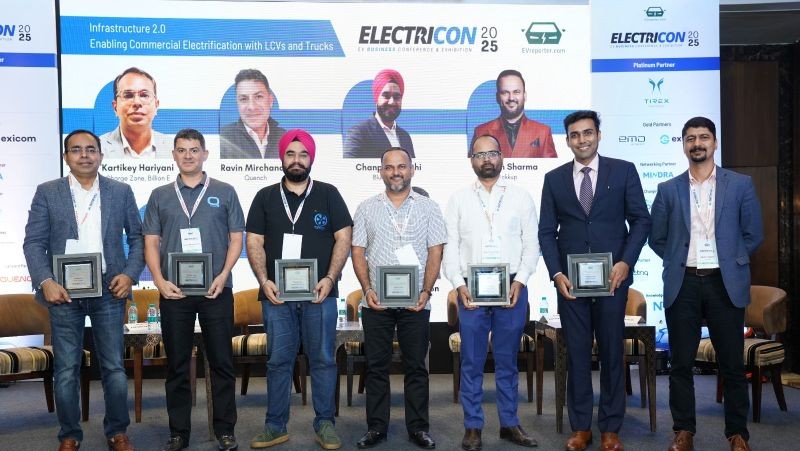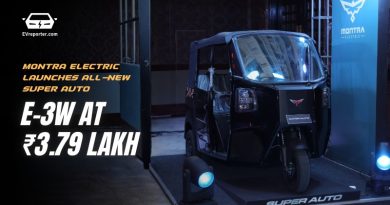India’s Freight Electrification at an Inflection Point: Key Take-aways from the Panel
At Electricon 2025, we were fortunate to witness a candid, data-rich discussion among India’s leading commercial-EV stakeholders. Below is the distilled intelligence from the high-stakes panel moderated by Krishna Pathak (Co-founder of Green Alpha), who deftly framed this session around mid- and long-haul freight electrification.
Kartikey Hariyani – Founder, ChargeZone (CPO) & Billion Electric (Fleet Operator)
- Started ChargeZone in 2019; the network now boasts of 14,000+ chargers in 40+ cities. ChargeZone dispenses 12 million energy-units/month, up from 10,000 units a month back in 2019.
- Spun off Billion Electric to run 100+ e-trucks (14 ton, 19 ton, 55 ton) on fixed routes like Bangalore-Chennai, Bangalore-Hyderabad. Targets to deploy 250 electric trucks.
- Key challenge: cost of capital. Lenders demand 14-18% IRR because they lack battery-residual data.
Proposed solutions:
- Recommends the RBI tag EV financing as a “priority sector” to cut the cost of financing.
- IoT dashboards or real-time battery health APIs for banks, financiers and insurers;
Told customers: “Treat the truck as an energy-asset on wheels; give us 7-8 year contracts and we’ll match diesel rates.” BillionE has secured long-term contracts from a diverse customer base spanning cement, e-commerce, pharma, steel, FMCG, automotive, and global logistics.
Ravin Mirchandani – Chief Dream Merchant, Quench (EV Charger OEM)
- Ador is a 120-year-old family business; Quench was born in lockdown. Their EV chargers now live in Australia, Brazil, the UK, and Italy. Recently launched 3W chargers as well.
- India pain-point: non-standardisation — every OEM tweaks the CAN-bus logic; “first charge in India always fails.”
- Predicts India will leap-frog via cost-down jugaad, but only if safety (thermal-runaway) is safeguarded.
Anticipates a paradigm shift in freight electrification. When asked about long-haul electrification sceptics, he pointed to BYD’s March announcement of a 5-minute 500 km charge. Technological leaps along with the plunging battery prices, will rewrite long-haul economics in favour of EVs.
Chanpreet Singh – Founder, BluWheelz (Mid-mile EV Fleet Operator)
- Chanpreet, a serial entrepreneur with 20 years of experience in the trucking industry, pivoted to EVs in January 2023. BluWheelz now serves 90+ clients in 7 cities by operating e-LCVs. The company clocked a revenue of INR 30 crores last year. Aims to add 1,000 4W EVs and generate a revenue of INR 70 crores this year.
- Believes EV freight is here to stay. Shared an interesting use case – “A large logistics company asked for a 5% TCO edge for their 250 km run on a 2-ton vehicle to commission large-scale EV operations. We were able to give them a 10% TCO advantage and still earn 10% by sweating the assets enough to reduce our opex vis-a-vis diesel”.
- Highlighted challenges for the industry: Customers compare EV rates with 10-year-old diesel trucks; a mindset shift is needed. No GST benefits, no import duty relief on chargers. Financing remains an issue.
- Retrofits vs native EV architecture: Feels retrofits might work for 2–3 ton LCVs; 14 ton+ vehicles need a ground-up approach and skateboard chassis to safeguard payload and battery placement.
- Welcomes global players (BYD, Tesla) to India. “Let the big boys in; we’ll learn and indigenise.”
Ankush Sharma – CEO & Co-founder, Pickkup.io (4W LCV Fleet Operator)
- Started in Mohali 4 years ago.
- Pickkup operates a pure-play 4W electric LCV fleet across Mohali, Delhi-NCR and now Bangalore for last and mid-mile deliveries. The company prioritises business sustainability over scale.
Ankush explained that while 3Ws dominate entry-level EV logistics, they don’t fit Pickkup’s efficiency and scalability model. Reasons:
- Payload Limitation: The 700 kg payload ceiling on 3Ws restricts asset utilization. In contrast, 4W EVs handle over 1 ton, enabling higher throughput per vehicle.
- Multi-Shift Operations: 4Ws support a full-day cycle—milk runs at 6 AM, pharma deliveries by noon, and dark store replenishments by 8 PM. This multi-shift model is essential to achieving EBITDA/overall profitability without relying on subsidies.
- Route Efficiency: Dark-store hub-and-spoke models require 150+ km daily loops—well beyond the capability of most 3Ws.
- Favourable TCO: When scaled, the total cost of ownership for 4Ws becomes significantly more favourable compared to 3Ws.
- Scalable Intercity Logistics: With vehicles now offering 150–200 km range per charge and fast-charging compatibility, intercity loops are already operational. The next frontier is 500 km routes in a day, enabling long-range electric logistics as the industry shifts toward higher payload and extended-range EVs.
Ajay Pratap Singh – CEO & Co-founder, SwitchLabs (Heavy e-truck Operator)
- Mechanical engineer & ex-solar developer; Deployed the first third-party-owned heavy-duty e-truck in July 2024. The company is focused on closed-loop, fixed-route logistics (cement, steel, ports) using heavy-duty electric trucks.
- Repeat orders from a cement major have pushed SwitchLabs’ fleet size to 60 electric trucks.
- Case in Point – A 55-ton truck deployed by SwitchLabs completed 1.15 lakh km in year 1, compared to 60–70,000 km for the diesel twin. The company sees 9,800 km/month utilisation vs 6,000 km for diesel on the same route.
- Driver fatigue drops 30–40 %—no clutch, no gear, no engine heat. A driver who used to max out at 150-170 km now does 200 km in a single stretch if the battery allows.
- Unit-economics mantra: “Positive unit economics on every single deployment—no exceptions and no subsidy crutches.”
Anant Tandon – National Customer & Digital Manager, Jio-bp pulse (EV Charging Infrastructure Provider)
Jio-bp pulse boasts of 6,000+ connectors, 800 sites, 200 highway plazas every 200 km; plans to increase network multi-fold with every passing year. “We’re Not Building for Tomorrow—We’re Building for Day-After-Tomorrow”, said Anant.
- Financing view – data transparency from OEMs on battery degradation will cut lender risk premiums and interest rates.
- Feels that the electric LCV infrastructure is already solved. However, his personal opinion for EV trucks is that battery swapping can be a probable solution for heavy trucks, because the biggest pain point for CPOs is the availability and quality of power at charging locations.
- Cited China’s example where 29,000 swap-capable trucks are operating; wants OEMs to design swappable packs and suggested Indian companies should replicate the model on fixed lanes like Delhi-Mumbai.
Our Takeaways
The industry needs to beat diesel on its own spreadsheet, without any reliance on subsidies.
Mechanisms to assure the lenders on battery state of health and residual value are required to solve financing.
The race is no longer about which powertrain will win—it’s about who locks in the capital, contracts and corridors.
This article was first published in EVreporter Aug 2025 magazine.
Also read: The electrification mandate for 2W ride-hailing needs to address on-ground challenges first
Subscribe today for free and stay on top of latest developments in EV domain.






